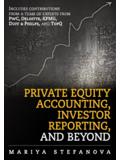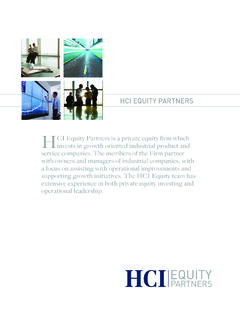Transcription of Private equity roundup Africa - EY
1 Private equity roundupAfrica03 Introduction04 Economic overview08 Fund-raising12 TransactionsContents16 Exits18 OutlookPrivate equity roundup Africa1 For additional information about PE investment in Africa and other emerging economies,visit the last several years, the emerging markets have evolved into a critical pillar of global investors strategies. As growth rates declined across most of the developed world in the aftermath of the credit crunch, Private equity (PE) firms turned to emerging markets as an engine of growth. Just five years ago, the emerging markets represented approximately 12% of total PE fund-raising.
2 Now, they account for more than 20%. While global investor interest has begun shifting back in favor of the growing developed economies in recent months and away from some of the emerging economies that have weaker economic or political environments, Africa 's strong long-term growth fundamentals should continue to drive the development of the PE industry on the s Private equity roundup series delves into the drivers of fund-raising, investment activity and exits across a range of developing economies, including Africa , China, India and Latin America. Our quarterly, semiannual and annual reports deliver fresh insight into the forces shaping activity, including macroeconomic trends, regulatory developments and capital markets in touch with Private equity at EY:On the web at Twitter at @EYPrivateEquityPrivate equity roundup : Africa is part of a series from EY focusing on Private equity activity in the emerging equity roundup AfricaPrivate equity roundup Africa3 With a third of African countries growing at more than 6% annually, Africa has certainly arrived on the global economic landscape.
3 The continent has demonstrated economic stamina over the last few years, emerging relatively unscathed from the financial crisis in comparison with most other regions and continuing to grow rapidly despite concerns about slowing growth in other emerging markets, such as China and India. Today, the continent accounts for many of the world s fastest-growing economies, driven by an expanding middle class, improved business environments and increasingly stable political democracies. The PE community in Africa has been growing steadily in recent years and is now entering a new level of maturity. Our analysis in this year s Africa PE roundup reflects that the African PE industry is gradually coming out of its infancy, with a variety of both global and local players exploring opportunities beyond the already established market of South growing limited partner (LP) appetite for the region is reflected in improved fund-raising numbers, and 2013 saw some notable fund announcements by leading PE firms.
4 PE investment activity (both value and volume) has increased since last year across a range of industries, with opportunities being explored in consumer-driven sectors and sectors benefiting from commodity-led and infrastructure-led growth. Sub-Saharan countries outside South Africa , such as Ghana, Kenya, Nigeria, C te d Ivoire and Uganda, are attracting increasing investor have been relatively muted in 2013, primarily because of external events. However, the pipeline for exits in the medium term looks strong as there have been a significant number of PE investments on the continent over the last five years, and many PE firms now have maturing portfolios that are ripe for findings for African PE in 2013: US$ was invested in 98 PE investments.
5 US$ was raised through PE funds closed. LPs rated Africa as the most attractive emerging market.* Half of all African countries (27) are now "middle income" countries.** Unique PE investment strategies and platforms are evolving.*2013 Global Limited Partners Survey, Emerging Markets Private equity Association**As defined by the World Bank (see definition on page 5)4 Private equity roundup AfricaEconomic overview1 Africa maintains growth momentum Africa is experiencing the longest period of sustained and robust economic growth since the 1960s. The continent s economic output has risen almost fourfold since 2000 to over US$2t.
6 This has been a remarkable feat given the unprecedented global economic conditions that have prevailed in the aftermath of the credit crunch in 2007, and it is testament to the deep-seated changes that have taken place in the political, legislative and business environments within countries. From 2000 to 2009, Africa had the highest number of economies growing above 7% per annum of any continent in the world (albeit from a lower base).Going forward, the International Monetary Fund (IMF) predicts that African countries are likely to post relatively higher economic growth rates compared with some developed and emerging nations.
7 According to the IMF, between 2011 and 2015, 7 out of the 10 fastest-growing economies in the world will be in Africa , and by 2017, that number will grow to 11 out of 1. Africa accelerates past Asia**Highest number of countries that grew at 7% annually on average over 2000-09 Source: Renaissance CapitalFigure 2. Africa s economic output (GDP, US$b)Source: IMF World Economic Outlook Database024681012 AsiaAfricaCISM iddle EastLatin , , , , AfricaNorth AfricaFrom 2000 to 2009, Africa had the highest number of economies growing above 7% per annum of any continent in the equity roundup Africa5 Economic overviewFigure 3.
8 Sub-Saharan Africa s contribution to GDP (%)Source: EY s Africa Attractiveness Survey 2013. Data originally from The World Development Indicators, World Bank, 6 February 2013 Diversifying away from resource-driven growthAlthough resources will continue to be an important contributor for growth on the continent the capital-intensive oil and gas sector alone has attracted 40% of the greenfield FDI capital into the continent since 2003 there is an ongoing structural shift toward more broad-based service-driven economies that are less reliant on volatile commodity 2000 11, in which the size of Africa s GDP has trebled, natural resources (excluding agriculture)
9 Made an average contribution of less than 20% to growth, according to EY s Africa Attractiveness Survey 2013. The single greatest contributor to GDP was the services sector, accounting for close to 54% of growth over the contribution to Africa s economic growth in 2011 from the services sector58%Consumer demand remains resilient The rapid growth of the African middle class has made domestic demand a major driver of economic growth across the region. The African Development Bank estimates that Africa s middle-class population grew by more than 60% to 313 million over the last decade. A total of 27 African countries have already attained middle income status.
10 * It is estimated that if current growth rates are sustained, 13 more could reach middle-income status by (2000-11)AgricultureNatural resourcesManufacturingServices*The World Bank's criterion for classifying economies is gross national income (GNI) per capita. A country is classified as "middle income if it has GNI of between US$1,026 and US$12,475. We have counted Equatorial Guinea as middle income, although it is, in fact, the first African country to be classified as high income" ( , GNI per capita in excess of US$12,475).6 Private equity roundup AfricaEconomic overviewFigure 4. Africa s rise to middle incomeSource: EY s Africa Attractiveness Survey 2013.













![Employment Equity Act [No. 55 of 1998] - Welcome …](/cache/preview/d/d/0/6/0/9/b/f/thumb-dd0609bf308cea3d6ac0c26c1659c10d.jpg)

